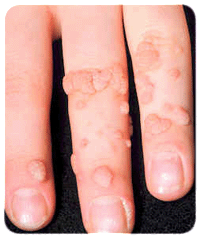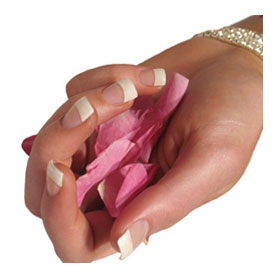Warts (Verrucae) are skin lesions that occur due to the effects of human papilloma virus (HPV) in the epidermis of the skin. HPV causes epithelial hyperplasia and various changes to the stations. Warts can be found as individual changes in the skin or mucous membranes, but it is more likely to see multiple warts. The appearance and size of warts depend on where they are, because they can change the look due to traumas and skin irritations.
Warts can last for years, but their lifetime duration is variable as well as the duration of their treatment. They can completely disappear after a few months, but also may appear after some time in another place.
Who Can Get Warts and How do They Occur?
Warts can occur at any age but is most common in children, and rarely in older people. Human Papilloma Virus (HPV), causes them and so far more than 80 types of viruses is identified. Certain types of viruses cause specific changes in the skin or mucous membranes. Warts can be caused by transferring the virus from man to man, and may be found in several different places on the same person because the virus transfers from one place to another on the skin. This form of transmission is called Authoinoculation. Warts often disappear spontaneously. The immune mechanism that leads to the withdrawal of the warts is not known, but it is known that in patients where the immune system is weakened due to the transplantation of organs or other infections, generalized skin lesions caused by HPVcan appear. Also, in certain professions, such as workers in the meat processing industry, for example, often have warts due to direct contact with fresh meat of animals that were infected with the HPV virus. The appearance of warts is present in athletes who have contact with water in indoor pools (water polo, swimming, etc.), because the virus transfers in the water-(Inoculation).
How to warts look Like?
Common warts (Verrucae Vulgaris) can appear anywhere on the skin. But they are usually localized in pressure places on the skin such as fingers, elbows, knees and soles. They are often below the nail and then they are extremely painful.
Warts on the Hands are the most common in young people.
They look as sharply limited nodes whose rough surface may be regular, round or of irregular shape. They are different colors, yellow, light gray, brown or dark grey. Size varies from a few millimeters to about 1 centimeter.
A special form of warts can be found on the soles of the feet. It is called: Plantarwarts (Verrucae Plantares). These warts have a flat surface and they occur due to the pressure and they can often be found in groups. They are most often located in places of the greatest pressure such as the heel or toes, and they cause pain when walking or running.

Juvenile Warts (Verrucae Planae Juveniles)-often occur in children and adolescents, they are flat, slightly elevated above the levels of the skin, have a smooth surface and yellow-brown colors. Very often they are on the face, and usually they are numerous because of the authoinoculation.
Other forms of warts that occur are called Threadwarts (Filiforme Verrucae)-Skin Tags. They are narrow and long, and usually these forms are at the eye lids, neck, lips and elsewhere on the face. They are common in men because they are passed over by shaving-authoinoculation.
.How to remove warts?
Most warts can spontaneously disappear in a few years. However, about 35% of warts occur in the same or new locations. Methods to remove warts, including:
- Kriotherapy (icing) by liquid oxygen for about 30 seconds (this therapy is effective but sometimes must be repeated after 2 to 3 weeks),
- Electrocoalgulation and Excohleation as methods can leave scars ... and so on. Each procedure depends on the type of wart, a place where they are, their duration, the patient’s age, and how they have reacted to already applied forms of therapy.
Altsberglotion - Corn and Wart Removal therapy of removing warts has been very successful for many years and is being implemented in the following way (but please check your medical coverage as some cheap medical insurance doesn't cover these types of procedures):
- Wash the affected place with warm water and neutral soap.
- The compound should be applied directly from the bottle or using the ear stick which has cotton wool in the end on the affected tissue and 0.5-1 cm. about it in a thin layer. The compound contains organic solvent, which evaporates quickly, and after applying the first layer you should wait 7-8 minutes. Let the balm dry and continue with the activities
- 12 h after applying the first layer apply a thin layer of balm on the same place. You are applying layer over the layer. Again, wait for 7-8 minutes. Let the balm dry and continue with the activities.
- Repeat the process until the affected place gets 7-8 thin layers (2 times a day, best before bedtime and morning).
- During this time, the place can be moistened by water but must not be rubbed (brush, sponge, etc..).
- After 14 days of applying the balm, you have allowed the medicinal substance from balms to do their job. During this time pay attention to the callus; do not attach any plasters, bandages etc. over it. Do not touch it by hands and do not remove the balm.
- 15th day, in the evening before bedtime put the foot in hot water and hold it 15 minutes. When the skin on the foot softens dry your feet using towel, wipe the callus gently and dig it out with your fingers. It will not hurt.
- If you remove the sick tissue and find a white spot whose diameter is 3 to 5 mm in the middle of a painful place, you should make a break of 1 to 2 days and repeat the procedure by applying 4 thin layers one over another in one day, and then let the balm act for 10 days. After that, the root will come out and you'll remove it by your fingers. That's because the process exists for a long time, ie. callus root was too deep to remove it by one therapy.
- Be persistent and we guarantee safe recovery.
Growths on the skin, particularly Warts, are due to viruses. Here are some tips to resolve this annoying problem:
- Learn to recognize the Wart.
- Learn which are of high risk.
- Pools are not the only dangerous places, but also all warm and humid places (gymnasiums, gyms, locker rooms ...)
- To reduce the risk, you should never go barefoot in places where an increased risk of infection exists.
- Each Wart is a special case
- Please contact us and we will solve your problem successfully.








